
Setting flexible goals, author Annie Duke says, helps you “to be more rational about when it’s the right time to walk away.”
According to her website, author and former professional poker player Annie Duke loves to dive deep into how to make decisions in uncertain times. Her latest obsession is on the topic of quitting. Her recently published book, Quit: The Power of Knowing When to Walk Away, is part of her mission to rehabilitate that term.
Duke no doubt draws from her card-playing experience — you’ve got to know when to hold ‘em, know when to fold ‘em, know when to walk away (thanks, Kenny Rogers) — to inform her mission, but she was also awarded a National Science Foundation Fellowship to study cognitive psychology at the University of Pennsylvania, so she is a longtime student of human behavior.
Duke starts off a Next Big Idea Club video (watch below) on quitting by sharing examples of runners who have injured themselves during marathons — even breaking their bones — who push through the pain and risk permanent injury to keep going. Why do they continue on? Because there’s a finish line, she says.
“Finish lines are funny things,” she says in the video. “You either reach them or you don’t. You either succeed or you fail. There’s really no in-between. Progress along the way matters very little. Once you set a specific goal, the grading is pass/fail.”

Goals are effective partly because they get you to focus on the finish line and motivate you to keep going, Annie Duke writes in her latest book..
What makes goals effective, in part, she says, is that they get you to focus on the finish line and motivate you to keep going. But they also keep you from quitting in a bad situation for the same exact reason.
Duke thinks that “clearly defined goals should come with a warning: Danger: You May Experience Escalation of Commitment.” Once we set a goal, we often fail to revisit it — we “set it and forget it,” she said. The goal becomes fixed, even as all the inputs that led to choosing that goal evolve. “The conditions in the world might change, our knowledge changes, the weights we attach to the benefits and cost” of reaching that goal, she says, might change. “Our preferences and values change. Inflexible goals just aren’t a good fit for a flexible world.”
One way to address this, Duke says, is to create more flexible goals. And, she says, the word “unless” is a powerful thing in this effort: “Adding a few well-thought-out ‘unlesses’ to our goals will help us achieve the flexibility we’re seeking.”
Goal setting should also come with a list of “kill criteria,” Duke recommends. That list gives you “the unlesses you need to be more rational about when it’s the right time to walk away.” What should be part of your kill criteria? It could be what the world is signaling to you, or changes in your preferences or values.
As it turns out, creating the kill criteria list is a sweet spot for planners: “These unlesses require advance planning,” Duke says. “You’re trying to anticipate as many scenarios that might unfold as possible.” Because you can’t imagine every factor that would cause you to stick with or quit your goal, Duke says you have to keep checking back in on the cost/benefit analysis and reevaluate your kill criteria and set new ones.
“Your goals should change because the world changes,” she concludes. “And you change. To keep up with all that, you need to check back periodically on whether you’re taking the fastest route to the finish line or if you’re even running to the right place.”
Michelle Russell is editor in chief of Convene.
